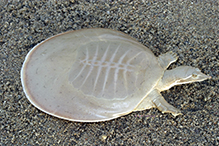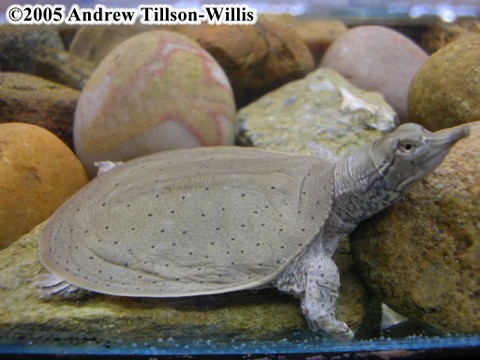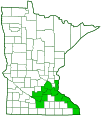smooth softshell
(Apalone mutica)
Conservation • Description • Habitat • Biology • Distribution • Taxonomy
Conservation Status |
|
|||||||
| IUCN Red List | LC - Least Concern |
|||||||
| NatureServe | N5 - Secure S3 - Vulnerable |
|||||||
| Minnesota | Special Concern Species in Greatest Conservation Need |
|||||||
Description |
||
Smooth softshell is a medium-sized to large freshwater turtle. Its historical range extends from western Pennsylvania to the Florida panhandle, west to North Dakota and eastern New Mexico. However, it is now believed to be extirpated from Pennsylvania. It is found in medium-sized and large rivers with sandy bottoms and fast or moderately fast currents, and in their tributaries. It is also found in lakes, marshes, and ditches near these river systems. In Minnesota it occurs in the Mississippi and Minnesota River systems in the lower third of the state. There are two subspecies of smooth softshell. Only the nominate species, midland smooth softshell (Apalone mutica mutica), occurs in Minnesota. Size is usually given as the length of the upper shell (carapace). The carapace of the female is oval, flat, and 6½″ to 14″ (16.5 to 35.6 cm) in length. It is smooth, leathery, and flexible on the edges. It is covered with skin. There are no scales (scutes), there is no central ridge (keel), and there are no spines on the front edge. The absence of the spines is what gives the turtle its common name. The background color is tan or brown and there are scattered dark blotches. The overall appearance has been described as resembling a chocolate chip pancake. The lower shell (plastron) is white or gray. There are no markings, but the underlying bones are visible. The upper side of the head, neck, limbs, and tail are colored like the carapace. The chin is white. A white line bordered by black extends from behind the eye to the neck. The snout is elongated and tube-like. The nostrils are round. There is no lateral ridge extending into each nostril. The male is similar to the female but much smaller. The carapace is 4½″ to 10½″ (11.5 to 26.6 cm) in length. The tail is thicker. On males and juveniles the carapace is brown or gray with dark dots or dashes. ----------------------------- The description above refers to the midland smooth softshell (Apalone mutica mutica). |
||
Size |
||
Male carapace length: 4½″ to 10½″ (11.5 to 26.6 cm) Female carapace length: 6½″ to 14″ (16.5 to 35.6 cm) |
||
Similar Species |
||
Habitat |
||
Medium-sized and large rivers with sandy bottoms and fast or moderately fast currents, in their tributaries, and in nearby lakes, marshes, and ditches |
||
Biology |
||
Behavior |
||
Softshell turtles are fast swimmers, fast diggers, and fast movers on land. They often bury themselves in the sandy bottom. Just the tip of the snout breaks the water surface and acts as a snorkel, allowing them to remain submerged for long periods. |
||
Lifespan |
||
Softshell turtles do not form growth rings on their shells, so determining their age in the field is difficult. They are believed to live up to 20 years in the wild. |
||
Life Cycle |
||
In June or early July the female lays a single clutch of usually 15 to 25 eggs. The eggs are spherical and white, resembling ping pong balls. They hatch in two or three months, August to September, depending on the temperature of the sand. |
||
Food |
||
Mostly larvae and aquatic forms of insects, but also fish, amphibians, snails, mollusks, and crayfish. |
||
Distribution |
||||
|
Sources |
|||
| 3/20/2023 | ||||
Occurrence |
||||
|
||||
Taxonomy |
|||
| Class | Reptilia (Reptiles) | ||
| Order | Testudines (turtles and tortoises) | ||
| Suborder | Cryptodira (hidden-necked turtles) | ||
| Superfamily | Trionychia (softshell turtles) | ||
Family |
Trionychidae (softshell and flapshell turtles) | ||
Subfamily |
Trionychinae (softshell turtles) | ||
Genus |
Apalone (American softshells) | ||
This species was formerly classified as Trionyx muticus. In 1987 all North American softshell turtles in the genus Trionyx were moved to the genus Apalone. |
|||
Subordinate Taxa |
|||
Gulf Coast smooth softshell (Apalone mutica calvata) midland smooth softshell (Apalone mutica mutica) |
|||
Synonyms |
|||
Amyda mutica Aspidonectes muticus Gymnopus muticus Trionyx muticus |
|||
Common Names |
|||
smooth softshell |
|||
Glossary
Carapace
The hard, upper (dorsal), shell-like covering (exoskeleton) of the body or at least the thorax of many arthropods and of turtles and tortoises. On crustaceans, it covers the cephalothorax. On spiders, the top of the cephalothorax made from a series of fused sclerites.
Plastron
The hard, lower (ventral), shell-like covering (exoskeleton) of the body of turtles and tortoises.
Scute
A hard, external scale that forms part of the exoskeleton; as on the belly of a snake, the upper and lower shells of hard-shelled turtles, and the foot of a bird.
Visitor Photos |
|||||
Share your photo of this reptile. |
|||||
| This button not working for you? Simply email us at info@MinnesotaSeasons.com. Attach one or more photos and, if you like, a caption. |
|||||
Jeff LeClere |
|||||
 |
|||||
MinnesotaSeasons.com Photos |
|||||
|
|||||

Slideshows |
||
| Smooth Softshell Turtle (Apalone mutica) Pierson Hill |
||
 |
||
| Smooth softshell turtle (Apalone mutica) Andrew Tillson-Willis |
||
 |
||

Visitor Videos |
|||
Share your video of this reptile. |
|||
| This button not working for you? Simply email us at info@MinnesotaSeasons.com. Attach a video, a YouTube link, or a cloud storage link. |
|||
Other Videos |
|||
| Smooth Softshell (Apalone mutica) Wisconsin Citizen-based Monitoring Network |
|||
About
Mar 13, 2013 Smooth Softshell profile: |
|||

Created: 3/20/2023
Last Updated:


